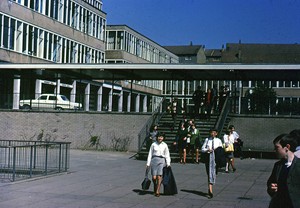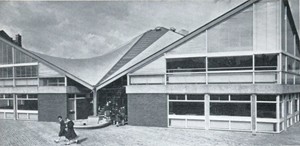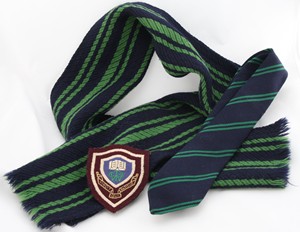School in the 1960s in the UK

Image by Phillip Capper licensed under CC BY-SA 2.0.
What was school like in the 1960s?
Big changes were happening in state education in the 1960s. At the beginning of the decade most children went to either grammar or secondary modern schools. Selection was at age 11 by the 11+ examination.
There were few comprehensive schools in 1960, but by the end of the 1960s, 26% of children of secondary school age went to comprehensive schools.
There was fierce debate amongst educationalists and politicians about whether to keep selection or abolish it.
What was school like in the 1960s compared to today?
Facts about school in the 1960s
- In the 1960s the school leaving age in the UK was 15
- In 1965 60% of children went to secondary modern schools, 19% to grammar schools and 8% to comprehensive schools in England and Wales (*)
- Typically the school day began between 8.45am and 9am and finished at 4pm
- The Certificate of Secondary Education (CSE) was introduced in 1965
- The number of pupils getting 5 or more GCEs or equivalent rose from 15% in 1960/61 to 22% in 1970/71 [1]
- In 1965, the Government issued Circular 10/65 requiring local authorities to submit plans to re-organize their secondary schools on comprehensive lines
- The percentage of UK children at comprehensive (non-selective) schools increased from 5% in 1960 to 26% in 1969
- Single-sex schools also declined in the 1960s. Still around 40% of secondary school children went to single-sex schools in the 1960s
- Up to 1968, all children at state schools got one third of a pint of milk a day free of charge, after 1968 over 11s at secondary school did not get free school milk
- Some subjects were gender-specific. Girls did cookery, needlework and typing; boys did woodwork and metalwork
- In many schools boys were referred to by the surnames and girls by their first names, but this was changing
(*) Percentages are for children aged 12 at maintained schools
At what age did you start school in the 1960s?
School started at age 5 in the 1960s. Children started school at the beginning of the term in which they had their 5th birthday. They were usually aged 4 when they first entered the school gates.
What was the school leaving age in the 1960s?
The school leaving age throughout the 1960s was 15.
Children were able to leave in the term following their 15th birthday. Those old enough were known as 'Easter leavers'. The last year of school was the 4th rather than the 5th year for many children in the 1960s.
Leavers at 15 left school with no qualifications.

Image 1 - information
Types of school
In the 1960s there were primary and secondary schools as there are today. The age range at primary school was 5 to 11 and at secondary school 11 to 18.
Primary schools were organised into infants and juniors, as they were in the 1950s.
Children stayed at school beyond age 15 to study GCE O-levels, CSEs (from 1965) and from 16 to 18 to study GCE A-levels.
For many children going to state school in the 1960s there was an examination taken in the spring term at primary school at age 11, the 11-plus. It decided whether they went to grammar school, a technical school or a secondary modern.
In some areas the 11+ had been abolished and children went to a comprehensive school. In some there was a combination of grammar and comprehensives.
The Labour Government from 1964 pushed for an end to selection at age 11 and promoted comprehensive schools. In 1965 the Government published a circular which requested local authorities submit plans to convert to the comprehensive system. Some were eager; some complied; others delayed. The result was a wide variety of provision in different areas.
Were comprehensives or grammars better?
This is still a controversial topic today. There is no clear winner. There was a huge amount of literature produced about the 11+ and why it was a bad for some children. There was very little objective research into which type of school system was better overall.
There was much wrong with the 11+. 11 was a young age to make the selection. This age may have come from the pre-War era when the school leaving age was 14. There would have been very little point of having an examination at age 13 to select secondary schools when most pupils would leave the following year.
There was evidence that it was not accurate.
- Was age 11 too young for such a life changing examination?
- There was strong evidence it favoured middle class children
- Did it accurately select the most able children?
- There was very little difference in ability between the bottom stream of the grammar school entry and the top stream of the secondary modern
- Some working class children did not adjust well to the academic ethos of the grammars
GCE results steadily improved throughout the 1960s, mostly under the tripartite system. They hardly increased at all in the 1970s under mainly comprehensive regimes.
How many children went to grammar schools in the 1960s?
This table shows the number of children at each type of school at two dates in the 1960s
| Type | 1963 | 1968 |
|---|---|---|
| Secondary modern | 58% | 47% |
| Grammar | 26% | 23% |
| Technical | 3% | 2% |
| Comprehensive | 8% | 21% |
| Other | 5% | 7% |
Source: Secondary school reorganization in England and Wales, by Alun Griffiths, published Routledge and Kegan Paul in 1971, page 13
Subjects/Timetable
Some of the most popular subjects taken at GCE Ordinary level in the 1960s included:
- English Language
- Mathematics
- French
- Geography
- English Literature
- History
- Biology
- Physics
- Chemistry
- Art
Source: Derived from London University (Exam board) GCE results published in 'The Grammar School' by Robin Davis, published by Penguin 1967, pages 138-9

School uniform
School uniform was compulsory in grammar schools. Some secondary moderns also had school uniform; some did not. Pupils' attitude to uniform in secondary moderns was laxer than would be tolerated today. In the 1960s older boys at secondary moderns got away with jeans and winklepickers instead of smart trousers and black shoes. Some swapped the school blazer for a sports jacket or pullover.
In some schools girls wore blazers. In others the uniform was a skirt, cardigan, blouse and tie. Girls often wore summer dresses in the summer term. Traditional-style gymslips were much less common in the 1960s.
Discipline and punishments
Corporal punishment was still common in schools in the 1960s. The ultimate sanction was the cane administered by the head. In the film Kes (1969), Billy Casper and his friends get caned for smoking. The brutal headmaster thinks nothing of caning boys, although he admits it will do no good.
Form teachers also administered punishment using rulers, gym shoes and in one school wooden 'whackers' made by the woodwork master.[2]
Detention and lines were also common for lesser offences. Prefects also doled out punishments in many schools.
Films and TV about schools in the 1960s
- To Sir, with Love (1967)
- The Pure Hell of St Trinian's (1960)
- The Great St Trinian's Train Robbery (1966)
- Please Sir! (Television series 1968-72)
Not just about schools Kes (1969) based on Barry Hines' book 'A Kestrel for a Knave' featured scenes filmed at St Helen's County Secondary School, Carlton Road Barnsley. It was a typical newly-built secondary modern.
References
[1] 'Education: historical statistics' by Paul Bolton, House of Commons Library, last updated 27 November 2012, page 19
[2] 'Life in a secondary modern school' by John Partridge, published by Penguin in 1968, page 111
Image information
[Image 1] Published as part of the Britain an Official Handbook in 1962 under Crown Copyright. Duration of copyright is fifty years after publication. So this image is public domain.
By Steven Braggs, May 2021


Comments
You forgot about hurling board rubbers as 'discipline' measure.
I went to a Secondary Modern school in the Black Country from 1959 to 1963. On the first assembly the Headmaster said that they didn't do external exams, like GSE, because you didn't need them on the factory floor. At that time about 22% of grammar school kids went to University and 8% of Sec Mod kids went. Believe me, in the Black Country it was about 5% Grammer kids and 1% Sec Mod kids......why? Because it's was on no ones radar. You left school and brought in a wage. Simple as that.
Stepney green secondary school